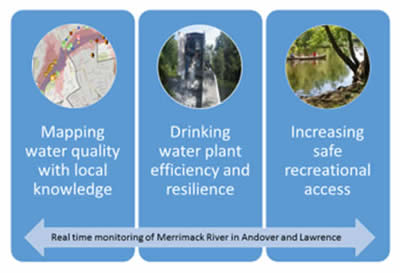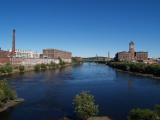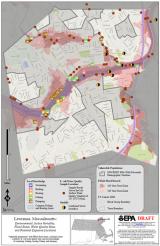Lower Merrimack Initiatives
Making a Visible Difference in Communities
EPA's "Making a Visible Difference (MVD) in Communities" initiative coordinates technical assistance and other resources across EPA programs with states, tribes, local governments and with other federal agencies to support communities as they pursue environmental improvements that enhance economic opportunity and quality of life.
Find out more about the Making a Visible Difference in Communities here.
Explore the Making a Visible Difference in Lawrence story map.
- Stakeholder Involvement
EPA is engaging with, and listening to, the Lawrence community to help pair priority needs with EPA's mission through stakeholder meetings. Participants include Lawrence City officials, non-profit organizations, state and federal agencies. This self-directed stakeholder group meets to address the high-priority issues identified through facilitated meetings. Topics such as litter; urban waters (including water quality and water treatment plant resiliency); employment and job training; and community engagement and education have come to the forefront as major issues of concern that are being addressed through the sub-teams. Please see the list of partners who are working with us on this effort.
- Water Strategy for Merrimack River

The Lawrence water strategy was developed as part of EPA's effort "Making a Visible Difference in Communities." It focuses on: 1) understanding more about the quality of Merrimack River water and mapping locations of potentially vulnerable sites and conditions; 2) ensuring that the facilities and infrastructure that provide safe drinking water are safe and secure; and 3) communicating the importance and value that the Merrimack River brings to Lawrence as both its source for drinking water and for recreation. EPA deployed two water quality monitors on the River to provide information on water quality every 15 minutes. This information is now available to the public through this website.
Understanding and mapping water quality Understanding and Mapping Water Quality for Lawrence, MA
EPA has created new maps of the lower Merrimack River that provide an overview of historic water quality data (E. coli concentrations); flood zones, precipitation, and combined sewer overflows (CSOs). In addition, the maps include information provided by local residents of known boating, swimming and fishing sites, localized flooding, as well as illegal dumping sites on the River. Collectively, city officials and local water associations can use this information to show potential locations where residents may be exposed to poor water quality and will be able to target appropriate communications through signage, flags or fact sheets.Securing drinking water infrastructure by analyzing flooding risk
In addition, EPA is undertaking a flooding vulnerability assessment of the Lawrence drinking water treatment plant, situated along the Merrimack River. EPA is using the real-time water quality data along with precipitation data to analyze flood risk at the treatment plant. EPA will provide an assessment report that includes preliminary designs that can be used by the City to improve drinking water plant efficiency and resiliency. The expected outcome will help Lawrence save money (by allowing it to change treatment as needed) and avoid impacts to important infrastructure, while protecting health in the event of extreme flooding.Spreading the word
The third component of the strategy is to provide a stronger connection for the community to the Merrimack River. EPA is working to expand residents' understanding of the River's value through education and communication. Efforts such as Water Boot Camp to introduce the next generation of drinking water operators to the importance of protecting the River, and support for events such as the Spicket River clean-up, EPA is helping to spread the word about the importance of Lawrence’s iconic rivers.- Drinking Water Resilience
 View a larger version of this image.Another component of the water strategy is a climate and flooding vulnerability assessment of the Lawrence drinking water system. In summer 2016, EPA is deploying real-time water quality monitors on the Merrimack River to provide information on water quality. EPA is also analyzing flooding risk with refined climate projection data. This data and modeling results produced by EPA can used by stakeholders to develop preliminary designs and improvements to both drinking water plant efficiency and supply resiliency. The expected outcome will help Lawrence save money and provide recommendations to increase the facilities' resilience to climate change.
View a larger version of this image.Another component of the water strategy is a climate and flooding vulnerability assessment of the Lawrence drinking water system. In summer 2016, EPA is deploying real-time water quality monitors on the Merrimack River to provide information on water quality. EPA is also analyzing flooding risk with refined climate projection data. This data and modeling results produced by EPA can used by stakeholders to develop preliminary designs and improvements to both drinking water plant efficiency and supply resiliency. The expected outcome will help Lawrence save money and provide recommendations to increase the facilities' resilience to climate change. - Water Boot Camp
EPA, working in close collaboration with Groundwork Lawrence, MassDEP, and Northeast Interstate Water Pollution Control Commission (NEIWPCC), is hosting Water Boot Camp for high school students. During these week-long sessions, students, learn about the water cycle, the importance of clean water, and potential career opportunities in the water industry.
- Drinking Water Resilience
Partners
Many dedicated stakeholders are working to improve Merrimack River water quality. Find out more about EPA's Lower Merrimack River partners.
-
City of Andover, MA Exit
The Water Division ensures the integrity of the water supplies and the surrounding watershed areas and is responsible for the treatment, quality control and distribution of the water in accordance with all federal and state regulations for delivery of the drinking water to the consumers. -
City of Lawrence, MA Water Department Exit
The mission of the Lawrence Water and Sewer Department is to provide the highest quality drinking water and wastewater collection services to ratepayers and stakeholders alike, protecting public health and safety. -
Clean River Project Exit
Clean River Project, a non-profit group which organizes volunteers to go out via boat and pull litter (tires, cars, debris) from the Merrimack River. -
Greater Lawrence Community Boating Exit
The largest public access boating program on the Merrimack River that provides safe, affordable boating opportunities to all residents of the Merrimack Valley. -
Groundwork Lawrence Exit
The mission of Groundwork Lawrence is to improve and manage the physical environment by developing community-based partnerships which empower people, businesses and organizations to promote environmental, economic and social well-being. -
Merrimack River Watershed Council Exit
The Merrimack River Watershed Council's mission is to "protect, improve and conserve the Merrimack River watershed for people and wildlife through education, recreation, advocacy and science." -
NEIWPCC - Northeast Interstate Water Pollution Control Commission Exit
NEIWPCC coordinates activities on water and wastewater issues by providing overall leadership in water management and protection to the New England states as well as New York.



